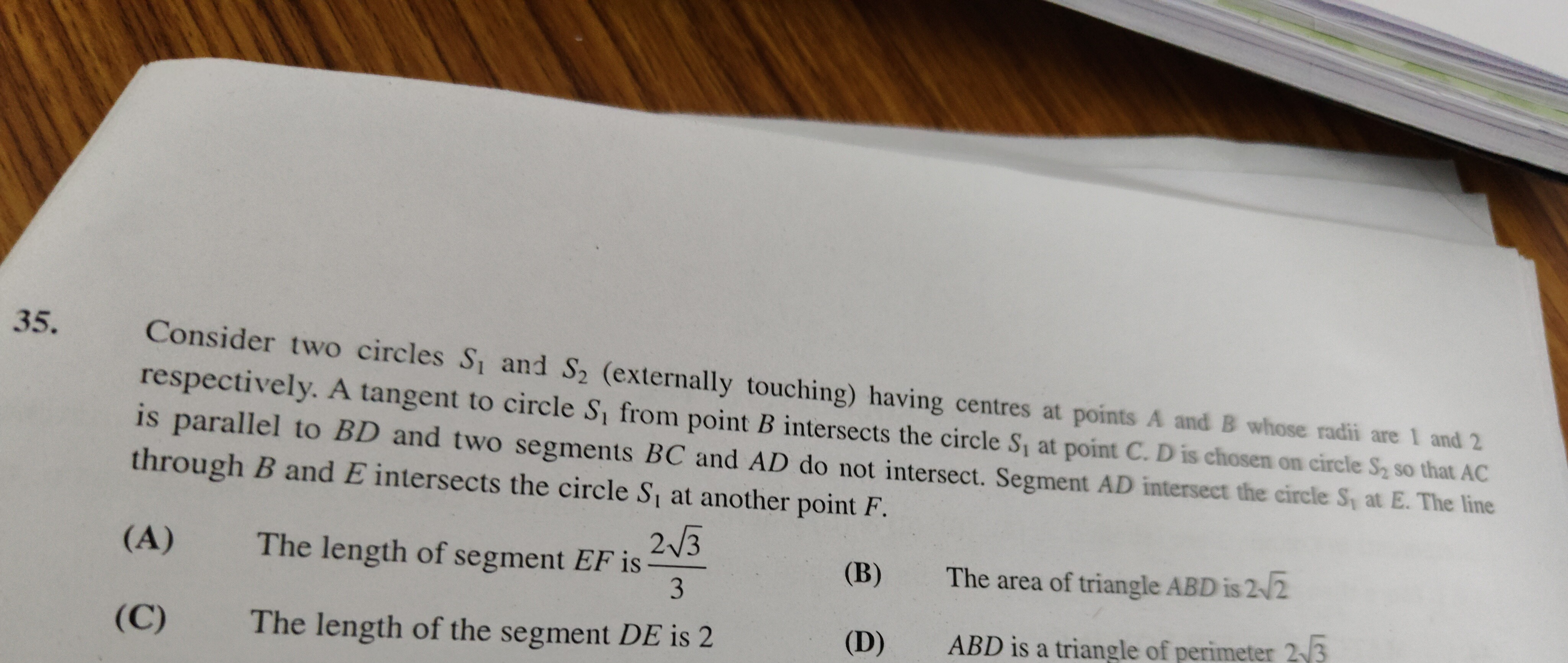Question
Question: Consider two circles S₁ and S₂ (externally touching) having centres at points A and B whose radii ar...
Consider two circles S₁ and S₂ (externally touching) having centres at points A and B whose radii are 1 and 2 respectively. A tangent to circle S₁ from point B intersects the circle S₁ at point C. D is chosen on circle S₂ so that AC is parallel to BD and two segments BC and AD do not intersect. Segment AD intersect the circle S₁ at E. The line through B and E intersects the circle S₁ at another point F.

The length of segment EF is 323
The area of triangle ABD is 2√2
The length of the segment DE is 2
ABD is a triangle of perimeter 2√3
(A), (B), (C)
Solution
Let A be the center of circle S1 with radius r1=1, and B be the center of circle S2 with radius r2=2. Since the circles touch externally, the distance between their centers is AB=r1+r2=1+2=3. We place A at the origin (0,0) and B on the positive x-axis at (3,0). The equation of S1 is x2+y2=1. The equation of S2 is (x−3)2+y2=4.
BC is a tangent to S1 at C. Thus, △ABC is a right-angled triangle with ∠ACB=90∘. Using Pythagoras theorem in △ABC: AB2=AC2+BC2⟹32=12+BC2⟹BC2=8⟹BC=22. Let C=(xC,yC). Since C is on S1, xC2+yC2=1. The radius AC is perpendicular to the tangent BC. Thus, AC⋅BC=0. AC=(xC,yC) and BC=(xC−3,yC). xC(xC−3)+yC2=0⟹xC2−3xC+yC2=0. Substituting xC2+yC2=1, we get 1−3xC=0, so xC=1/3. Then yC2=1−(1/3)2=8/9, so yC=±322. Let's choose C=(1/3,322). So, AC=(1/3,322).
AC is parallel to BD. Since D is on S2, ∣BD∣=r2=2. BD=kAC for some scalar k. ∣BD∣=∣k∣∣AC∣⟹2=∣k∣⋅1⟹k=±2.
Case 1: BD=2AC. D=B+2AC=(3,0)+2(1/3,322)=(11/3,342). Line AD is y=1142x. Line BC is y=−42(x−3). These lines intersect for x=11/9, which lies on both segments AD and BC. This case is rejected.
Case 2: BD=−2AC. D=B−2AC=(3,0)−2(1/3,322)=(7/3,−342). Line AD is y=−742x. Line BC is y=−42(x−3). These lines intersect for x=−7/3, which does not lie on segment AD (as xD=7/3>0) or segment BC. This case is accepted. Thus, A=(0,0), B=(3,0), D=(7/3,−342).
E is the intersection of AD and S1. Line AD is y=−742x. Substituting into x2+y2=1: x2+(−742x)2=1⟹x2+4932x2=1⟹4981x2=1⟹x=±7/9. Since E is on segment AD starting from A, xE must have the same sign as xD. So xE=7/9. yE=−742⋅(7/9)=−942. So E=(7/9,−942).
Line BE intersects S1 at E and F. Line BE passes through B(3,0) and E(7/9,−942). Slope mBE=7/9−3−42/9−0=−20/9−42/9=52. Line BE: y−0=52(x−3)⟹y=52x−532. Intersections with x2+y2=1: x2+(52x−532)2=1⟹27x2−12x−7=0. One root is xE=7/9. Let the other root be xF. xE+xF=7/9+xF=12/27=4/9⟹xF=4/9−7/9=−3/9=−1/3. yF=52(−1/3−3)=52(−10/3)=−322. So F=(−1/3,−322).
\textbf{Evaluation of Options}
(A) Length of EF: E=(7/9,−42/9), F=(−1/3,−22/3)=(−3/9,−62/9). EF2=(7/9−(−3/9))2+(−42/9−(−62/9))2=(10/9)2+(22/9)2=81100+818=81108. EF=81108=963=323. Option (A) is TRUE.
(B) Area of △ABD: A=(0,0), B=(3,0), D=(7/3,−42/3). Area =21∣xA(yB−yD)+xB(yD−yA)+xD(yA−yB)∣=21∣0+3(−42/3−0)+0∣=21∣−42∣=22. Option (B) is TRUE.
(C) Length of DE: D=(7/3,−42/3)=(21/9,−122/9), E=(7/9,−42/9). DE2=(21/9−7/9)2+(−122/9−(−42/9))2=(14/9)2+(−82/9)2=81196+81128=81324=4. DE=4=2. Option (C) is TRUE.
(D) Perimeter of △ABD: AB=3, BD=r2=2. AD=∣D∣=(7/3)2+(−42/3)2=49/9+32/9=81/9=3. Perimeter =AB+BD+AD=3+2+3=8. 8=23. Option (D) is FALSE.
